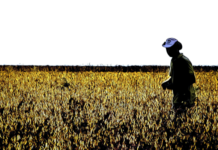La revisione sistematica con meta-analisi di 9 studi scientifici indipendenti, condotti su 184.389 persone, ha associato l’esposizione agli erbicidi (es. glyphosate, glufosinate ammonium, dicamba) to the significantly increased (+85%) risk of developing skin melanoma. (1)
There is a reaffirmation of the need to collect signatures to the European Citizens’ Initiative #SaveBees and Farmers. The only way to get the European Commission to actually adopt a strict and restrictive policy on the use of these and other toxic substances, in agriculture and green spaces. (2)
Cutaneous melanoma
Cutaneous melanoma is one of the forms of cancer whose incidence has increased significantly over the past 50 years, as well as being the deadliest of all dermal cancers. (3) It develops from tumor formations involving melanocytes, i.e., the cells in the epidermis responsible for the production of melanin (which in turn is useful for protection from the damaging effects of sunlight).
Risk factors are numerous, endogenous (related to certain phenotypes such as fair skin, red or blond hair, green or blue eyes) and exogenous (e.g., exposure to herbicides). (4) In contrast, chronic exposure to UV (ultraviolet) radiation, historically considered one of the most important risk factors, would appear to reduce the risk of developing skin melanoma. In fact, numerous descriptive epidemiological studies have found reduced risk in people who work outdoors. (5)
Skin exposure to herbicides
Skin exposure to herbicides is very common and frequent, due to their extensive and ongoing use in agriculture and other activities related to green management (e.g., parks, nurseries, flower beds, roadsides and railroad tracks). Therefore, in addition to occupational exposure, there is also environmental exposure – related to the so-called
drift effect
of agrotoxics – and dietary exposure (through consumption of ‘conventional’, i.e., non-organic, food). With possible adverse public health effects, potentially exacerbated bymultiple exposure. (6)
Unfortunately, the skin barrier is not enough to mitigate the absorption of toxic substances to pesticides that occurs right through the epidermis. It may occur during preparation and use or following such activities, during the changing and handling of clothing used by operators. Some parameters greatly influence the effect of this exposure. In particular:
– Extent and duration of exposure,
– Presence of other materials on the skin,
– ambient temperature and humidity,
– Use of tools and personal protective clothing (7,8).
Synergistic effects. Cocktail effect, sunshine and sunscreen
The so-called cocktail effect-that is, exposure to two or more active substances (e.g., glyphosate and glufosinate ammonium)-has been found to amplify exposure to agrotoxics. With synergistic effects so far poorly explored, particularly with regard to possible carcinogenic effects of pesticide mixtures. In fact, studies focus mainly on individual active ingredients or, at most, their reference classes. (9)
Sun exposure, in turn, appears to promote a synergistic effect with pesticides in professional workers. Solar radiation can result in increased skin temperature and increased blood flow and sweating, along with pesticide skin permeability. And the use of protective sunscreens further contributes to the skin absorption of pesticides, particularly in products that contain titanium dioxide or zinc oxide. (10)
Meta-analysis, research outcomes
The meta-analysis conducted by researchers from the Italian Melanoma Intergroup (IMI), together with those from theRomagnolo Scientific Institute for the Study and Treatment of Tumors (IRST), demonstrated a significant increased risk of melanoma development in individuals exposed to herbicides-especially professional workers-than in unexposed individuals.
Those most at risk appear to be men, due to higher occupational exposure. Other agrochemicals (e.g., pesticides, insecticides) have also demonstrated high risk, both at high and continuous exposures, although it did not appear to be statistically significant with regard specifically to skin melanoma. In any case, the set of results will need to be confirmed in further studies.
Comparing legal systems
Levels of protection for public health and ecosystems are very different in different legal systems. While the European Union is struggling to address the risks of multiple exposure ( cocktail effect), other countries continue to authorize agrotoxics long banned in the EU. These include top exporters of agricultural commodities such as Brazil, India and Indonesia (where paraquat is still in use), USA, etc. (11,12,13).
Dario Dongo and Andrea Adelmo Della Penna
Cover image by NSAE
Notes
(1) Stanganelli I, De Felici MB, Mandel VD, Caini S, Raimondi S, Corso F, Bellerba F, Quaglino P, Sanlorenzo M, Ribero S, Medri M, Farnetani F, Feliciani C, Pellacani G, Gandini S; IMI the Italian Melanoma Intergroup. (2020). The association between pesticide use and cutaneous melanoma: a systematic review and meta-analysis. JEADV (Journal of the European Academy of Dermatology and Venereology) 2020 Apr;34(4):691-708. doi: 10.1111/jdv.15964. Epub 2019 Oct 28. PMID: 31541557
(2) Dario Dongo. Savethebees! Save the bees, European citizens’ initiative. Égalité. 15.1.21, https://www.egalite.org/savethebees-salviamo-le-api-iniziativa-dei-cittadini-europei/
(3) Gandini et al. (2005). Meta-analysis of risk factors for cutaneous melanoma: I. Common and atypical naevi. Eur. J. Cancer 41: 28-44, doi:10.1016/j.ejca.2004.10.015
(4) Leonardi et al. (2018). Cutaneous melanoma: from pathogenesis to therapy (Review). International Journal of Oncology 52(4):1071-1080, doi:10.3892/ijo.2018.4287
(5) Parkin et al. (2011) 13. Cancers attributable to solar (ultraviolet) radiation exposure in the UK in 2010. Br. J. Cancer 105(Suppl. 2):S66-S69, doi:10.1038/bjc.2011.486
(6) Alavanja (2009). Introduction: pesticides use and exposure extensive worldwide. Rev. Environ. Health 24(4):303–309, https://doi.org/10.1515/REVEH.2009.24.4.303
(7) Anderson et al. (2014). Potential health effects associated with dermal exposure to occupational chemicals. Environ. Health Insights 8(Suppl 1):51-62, doi:10.4137/EHI.S15258
(8) Damalas et al. (2011). Pesticide exposure, safety issues, and risk assessment indicators. Int. J. Environ. Res. Public Health 8(5):1402-19, doi:10.3390/ijerph8051402
(9) Fortes et al. (2016). Occupational exposure to pesticides with occupational sun exposure increases the risk for cutaneous melanoma. J. Occup. Environ. Med. 58:370–375, doi:10.1097/JOM.0000000000000665
(10) Gordon et al. (2005). Thermal stress and the physiological response to environmental toxicants. Rev. Environ. Health 20:235-263, doi:10.1515/reveh.2005.20.4.235
(11) Donley (2019). The USA lags behind other agricultural nations in banning harmful pesticides. Environ. Health 18:44, https://doi.org/10.1186/s12940-019-0488-0
(12) Muhamad Ramdan, Iwan & Candra, Krishna Purnawan. (2020). Factors Associated with Cholinesterase Level of Spraying Workers Using Paraquat Herbicide at Oil Palm Plantation in East Kalimantan, Indonesia. doi:10.14710/jkli.19.1.16-20
(13) Dario Dongo, Donato Ferrucci. Pesticides, acute toxicity in the US agricultural system. Scientific study. GIFT (Great Italian Food Trade). 25.8.19, https://www.greatitalianfoodtrade.it/idee/pesticidi-tossicità-acuta-nel-sistema-agricolo-usa-studio-scientifico









